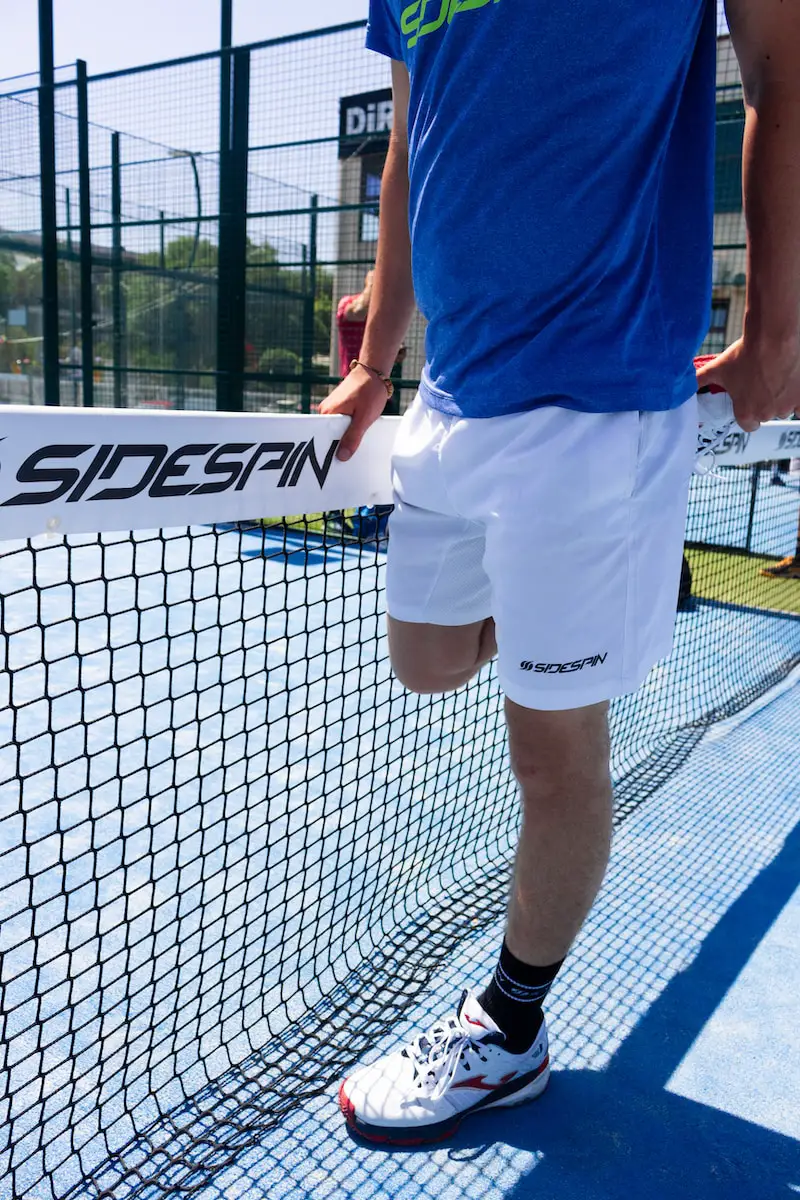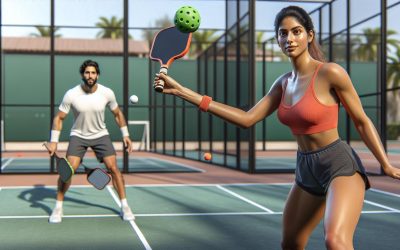If you’re like me, you’re always looking for ways to up your pickleball game. One key component that’s often overlooked is stretching. Now, I’m not just talking about a quick toe touch before you serve. I’m talking about a dedicated stretching routine that prepares your body for the swift, agile movements pickleball requires.
You might be thinking, “I’ve played pickleball for years without stretching and I’ve been just fine.” But let me tell you, incorporating stretching into your pickleball routine isn’t just about preventing injury. It’s about enhancing your performance, increasing your range of motion, and giving you that extra edge on the court. So, let’s dive into the world of pickleball stretches, shall we?
The Importance of Stretching for Pickleball
There’s no denying that stretching forms an integral part of every successful pickleball player’s routine. But, what actually makes stretching so critical in pickleball? We often think of stretching as a staple in the world of athletics, yet it plays an even more significant role than just warming up or cooling down.
Enhanced Performance
One of the most significant benefits of stretching is the enhancement in performance it offers. The simple act of stretching before the game can increase your range of motion, boosting your overall performance in the pickleball court. In other words, stretching directly translates to better shots and more control over your body movements.
Injury Prevention
Constant intense pickleball games can take a toll on your body. Without proper stretching, you’re inadvertently increasing the risk of muscle strains, sprains, and other injuries. Stretching not only warms up your muscles but also prepares them for the action, substantially reducing the risk of injuries.
Improved Range of Motion
Range of motion is crucial in achieving effective shots or serves during the game. Stretching loosens up the muscles, and improves the fluidity of motion in your joints. It increases your ability to reach farther, hit harder, and move faster. Increased flexibility and movement quality give you an undeniable edge on the pickleball court.
Faster Recovery
After a heated game of pickleball, you may feel aches and stiffness in your muscles. Incorporating a post-game stretch as part of your routine can aid in faster muscle recovery. It facilitates better circulation, alleviating the pain and helping your body recover promptly.
It’s clear that incorporating a comprehensive stretching routine into your pickleball practice can yield multifaceted benefits. The act may appear simple; it’s overall impact, though, is far from it. You’ll not only be better equipped on the court but pose as a formidable adversary to your opponents. However, equally important as stretching before and after games is knowing the correct stretches and how to do them.
The Benefits of Incorporating Stretching into Your Pickleball Routine
Stretching plays an essential part in improving your pickleball game, far beyond its well-known role in injury prevention. It’s a tool for enhancement, an avenue for gaining an edge on the court. So, what benefits can you expect by making stretching a routine part of your pickleball regimen?
As mentioned—Firstly, stretching enriches performance. By increasing your range of motion, it paves the way for more freely flowing, energetic, and efficient movements. The more mobile and flexible your joints and muscles are, the better your strokes, serves, and returns become. In turn, this improvement may give you an upper hand in the game.
Secondly, stretching helps fend off injuries. Regularly doing stretches, especially dynamic ones before the game, reduces the risk of strains and sprains. It acclimates your muscles to the motions they’ll perform on the court, making them less likely to get injured.
Lastly, but definitely not least, stretching aids in recovery. Incorporating static stretches after the game, for instance, can help your muscles recover quicker. It promotes blood flow, alleviates post-game stiffness, and reignites flexibility. Waking up the next day without muscle soreness or tightness can be just the ticket you need for consistent practice or play.
Of course, gaining these benefits from stretching hinges on knowing and doing the correct stretches. In the journey of achieving your pickleball best, knowing the most effective stretches and executing them right can be a game-changing ally. With consistent effort and patience, you’re likely to see improvements on and off the pickleball court.
Understanding the Key Movements and Muscles Used in Pickleball
Becoming a more proficient player often means understanding the game at a deeper level. So, let’s take a good look at the primary movements and muscles we use while playing pickleball.
While pickleball might resemble tennis or ping pong at first glance, it’s a unique game with its own set of motions and demands placed on your body. The game emphasizes a mix of movements that recruit a variety of muscle groups. Consistent with strategies required in most racket sports, pickleball requires not only agility and hand-eye coordination but also demands an engaging combination of muscular strength and endurance.
One of the main muscle groups involved in pickleball includes the upper body, specifically the deltoid muscles – the meaty cap filling out our shoulders. Not only does the deltoid stretch and contract as we swing our paddles, but it’s also a driving force behind our serves and returns, making it a key player in our game tactic arsenal.
Apart from this, abdominals and back muscles come into play extensively. Without realizing it, we engage these core muscles to hold our balance, pivot, twist and turn our upper body in response to our opponents’ volleys, proving that a strong core is vital for precise strokes and powerful serves.
Let’s not overlook our legs and glutes. They provide the stability and power needed for those quick-start sprints, spontaneous zig-zag movements, and lateral lunges to reach the ball.
Complementing our understanding of the muscles and movements, let’s shift our focus to the importance of stretching. By conditioning these key muscles through regular and focused stretching, I’m anticipating you’ll see improvements both on and off the pickleball court.
Pre-Game Warm-Up Stretches for Pickleball
Pickleball, a fusion of tennis, badminton, and ping-pong, calls for a diverse suite of muscle-recruiting movements. A pre-game warm-up routine is not just about raising body temperature and loosening muscles. It’s about priming these critical muscle groups for the dynamic actions they’ll perform on the court. This involves the upper body, the core, and the legs.
Upper Body Stretches facilitate shoulder mobility, vital for serving and striking in pickleball. Dynamic arm circles can be a great starting point. Begin with small circles, gradually working your way up to larger ones, both clockwise and counter-clockwise. It’s a simple yet effective stretch targeting the deltoids.
Another useful stretch is the chest expander. Stand tall, interlock your fingers behind your back, and gently pull your hands upward until you feel a stretch in your chest and shoulders. This helps to counteract the ‘hunched’ position that players often adapt while playing, promoting good posture and reduced risk of injuries.
Core Stretches matter too. Remember, the core is the powerhouse of your body. It provides the balance and precise strokes needed to play pickleball. The standing side stretch is a good option here. Simply stand straight, raise one hand overhead, and lean towards the opposite side. This helps to elongate and warm-up the oblique muscles, enhancing your lateral movement on the court.
Lower Body Stretches should not be ignored. The legs and glutes provide stability and power. The hip circles stretch is one I recommend. Stand with your hands on your hips, feet shoulder-width apart, and rotate your hips in a circular motion. This warms up the hip flexors and glutes, preparing them for the lateral and forward movements in the game.
In my experience, incorporating this suite of stretches into your pre-game routine can significantly benefit your game. It’s not just about preventing injuries but also enhancing performance. Regular and focused warm-ups can lead to notable improvements on the pickleball court, making the game more enjoyable and successful.
Dynamic Stretches for Pickleball
Shifting focus now, let’s talk about dynamic stretches, an integral part of an effective warm-up routine especially as a pickleball player. These types of stretches are performed in motion and intentionally designed to engage major muscle groups.
Dynamic stretches aren’t just stretches; they double as a light cardio workout. That’s why they’re superb for gradually increasing heart rate and body temperature. An excellent example of this is high knee marching or a straightforward walking lunge.
For your upper body, arm circles and shoulder rolls are your best bet. Arm circles involve extending your arms out to your sides and rotating them in small to larger circles for about 30 seconds. For those pesky hard-to-reach shoulder muscles, shoulder rolls, performed by slowly rolling your shoulders forwards and backwards, will do the trick.
To efficiently work your lower body and prime it for those challenging pickleball moves, you can’t go wrong with leg swings and ankle hops. Swing one leg forwards and backwards maintaining a slight bend in the standing leg. Ankle hops, carried out by jumping off the balls of both feet, are great for ankle flexibility and strength.
Your core is equally important in pickleball, so don’t neglect it. Hip circles are great for priming your abdominals, hip flexors, and lower back. Stand with your hands on your hips then rotate your hips in a circle making sure to keep the rest of your body still.
Remember, a proper warm-up, including these dynamic stretches, helps you stay limber and ready for action on the court. Incorporating these stretches into your routine, you’ll discover that your mobility and performance levels are notably enhanced. Working up gradually to full speed and intensity ensures that you don’t jump into rigorous pickleball games cold and unprepared.
Let’s move on to some additional strategies on how to further enhance your pickleball performance.
Post-Game Recovery Stretches for Pickleball
After a solid round of pickleball, it’s important to give the body what it needs to recover. That’s where post-game stretches come into play. They’re crucial for minimizing muscle soreness and maintaining flexibility, ensuring you’ll be prepared for your next competitive bout.
The most effective recovery stretches are usually static. This means they involve holding a stretch position for a specific length of time, typically between 15 to 60 seconds. Unlike dynamic stretches which get your blood pumping, static stretches help to slow the heart rate and allow for muscle relaxation and recovery.
Let’s look at these static stretches designed specifically for pickleball players:
- Upper body: Extend both your arms in front of you, intertwine your fingers and push outward. You’ll feel this in your shoulders and upper back. It’s a stretch that directly counteracts the impact of serving and volleying.
- Lower body: The quadriceps, most used muscles during a pickleball game, need relaxing too. Stand up straight, bend a leg backward, and hold the foot with your hand. You’ll feel a nice pull in your quads.
- Core: Finally, we can’t forget about the infamous abdominal muscles. Lie flat on your stomach, then push your upper body up while keeping your hips on the floor. This is also known as the cobra stretch and it helps in stretching the abs and lower back.
Utilizing these static stretches post-game is a valuable tool in your recovery arsenal. They not only help you reap the benefits of your exercise but also prepare your body for your next match. It’s important to understand that while they won’t eliminate the potential for muscle soreness, they will definitely help reduce it.
Conclusion
So there you have it. I’ve walked you through the power of dynamic and static stretches for your pickleball game. Dynamic stretches get your body moving, engaging major muscle groups and serving as a light cardio workout. They’re your key to unlocking enhanced mobility and performance levels on the court. On the flip side, static stretches are your post-game recovery heroes. They slow your heart rate, help your muscles relax, and minimize soreness, priming your body for your next match. Whether it’s arm circles before the game or cobra stretches after, remember that stretching isn’t just an extra—it’s an essential part of your pickleball routine. So lace up those shoes, grab your paddle, and let’s make every game your best game yet.














0 Comments